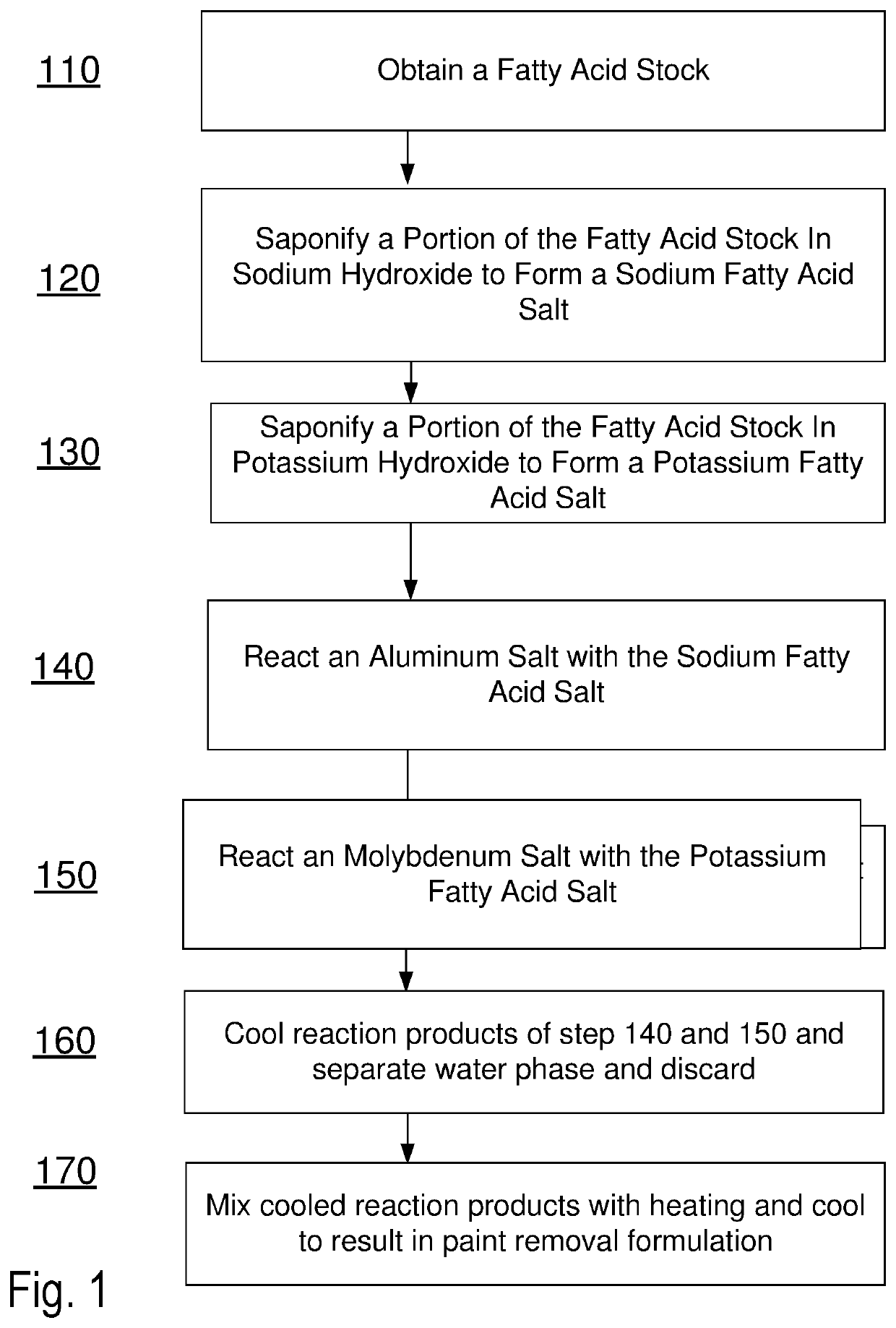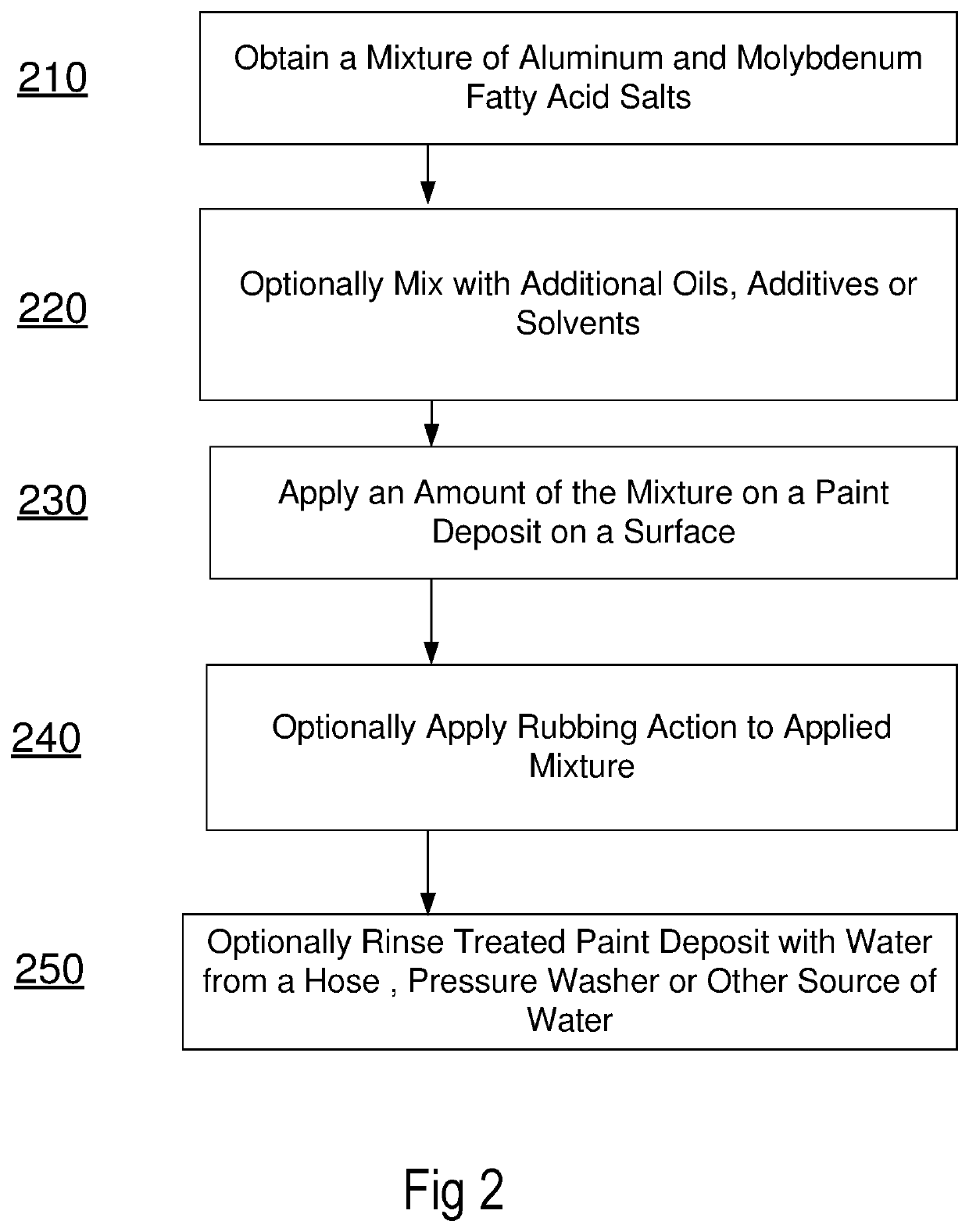Methods and formulations for paint deposit removal
a technology of liquid solution and paint, applied in the direction of coatings, chemical paints/ink removers, etc., can solve the problems of time-consuming, laborious, and expensive processes, and achieve the effect of safe use and affordabl
- Summary
- Abstract
- Description
- Claims
- Application Information
AI Technical Summary
Benefits of technology
Problems solved by technology
Method used
Image
Examples
example 1
[0070]Next the solid form result from “Part C” was melted in a beaker on a hot plate at 51.5° C. (125° F.) and brought to a stable temperature. When the material had fully melted and reached the stable temperature, it was added to the result of “Part D” and mixed thoroughly at 125° F. for 20 minutes. The resulting mixture was cooled and remained in a liquid form.
Example 2
Example 2—Part A
[0071]In a first main step, “Part A” 300 mL of water was added to a beaker and then placed on hot plate with stirring capability. Without heat, the water was stirred enough to create a good vortex in the beaker. In further processing, 44.3 mL (or 3 level tablespoons) equal to approximately 94 g of sodium hydroxide was added to the water while the solution continues to stir. The heat of dilution of the sodium hydroxide elevated the temperature of the solution. The solution was stirred until the sodium hydroxide was fully dissolved and the temperature reached a temperature in a range of approximately 2...
example 2
[0082]The fifth beaker from Part A was placed on a hotplate with stirring and brought to a temperature of approximately 43° C. (110° F.). The contents of the fifth beaker from Part B was slowly added to the fifth beaker from Part A and then allowed to stir with heating for 30 minutes to become an homogeneous mixture. After 30 minutes of mixing, the mixture was removed from the heating and allowed to cool to room temperature. This resulted in a product.
Example 3
Example 3—Part A
[0083]Another example of processing (Example 3) follows.
[0084]In a first main step, “Part A” 300 mL of water is added to a beaker and then placed on hot plate with stirring capability. Without heat, the water may be stirred enough to create a good vortex in the beaker. In further processing, 44.3 mL (or 3 level tablespoons) equal to approximately 94 g of sodium hydroxide was added to the water while the solution continues to stir. The heat of dilution of the sodium hydroxide elevated the temperature of the solu...
example 3
[0095]The fifth beaker from Part A was placed on a hotplate with stirring and brought to a temperature of approximately 43° C. (110° F.). The contents of the fifth beaker from Part B was slowly added to the fifth beaker from Part A and then allowed to stir with heating for 30 minutes to become an homogeneous mixture. After 30 minutes of mixing, the mixture was removed from the heating and allowed to cool to room temperature. This resulted in a product.
Aluminum Oxide General Processing
[0096]In preparing an aluminum salt reagent a number of processing examples have been practiced. In the various examples described previously, the use of different processing to dissolve aluminum oxide powder have been practiced. Hydrochloric acid is effective in dissolving aluminum oxide powder. Alternatively, another acid based process with Sulfuric acid is also effective. In a preferred manner, hot sodium hydroxide may be used to dissolve the aluminum oxide. In full processing examples for the produc...
PUM
| Property | Measurement | Unit |
|---|---|---|
| temperatures | aaaaa | aaaaa |
| temperature | aaaaa | aaaaa |
| temperature | aaaaa | aaaaa |
Abstract
Description
Claims
Application Information
 Login to View More
Login to View More - R&D
- Intellectual Property
- Life Sciences
- Materials
- Tech Scout
- Unparalleled Data Quality
- Higher Quality Content
- 60% Fewer Hallucinations
Browse by: Latest US Patents, China's latest patents, Technical Efficacy Thesaurus, Application Domain, Technology Topic, Popular Technical Reports.
© 2025 PatSnap. All rights reserved.Legal|Privacy policy|Modern Slavery Act Transparency Statement|Sitemap|About US| Contact US: help@patsnap.com


